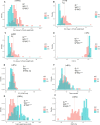Genomic regions associated with physiological, biochemical and yield-related responses under water deficit in diploid potato at the tuber initiation stage revealed by GWAS
- PMID: 34748612
- PMCID: PMC8575265
- DOI: 10.1371/journal.pone.0259690
Genomic regions associated with physiological, biochemical and yield-related responses under water deficit in diploid potato at the tuber initiation stage revealed by GWAS
Abstract
Water deficit, which is increasing with climate change, is a serious threat to agricultural sustainability worldwide. Dissection of the genetic architecture of water deficit responses is highly desirable for developing water-deficit tolerant potato cultivars and enhancing the resilience of existing cultivars. This study examined genetic variation in response to water deficit in a panel of diploid potato and identified the QTL governing this trait via a genome-wide association study (GWAS). A panel of 104 diploid potato accessions were evaluated under both well-watered and water deficit treatments at tuber initiation stage. Drought stress index (DTI) was calculated to assess tolerance of the diploid potato genotypes to water deficit. The GWAS was conducted using a matrix of 47K single nucleotide polymorphisms (SNP), recently available for this population. We are reporting 38 QTL, seven for well-watered conditions, twenty-two for water deficit conditions and nine for DTI which explain between 12.6% and 44.1% of the phenotypic variance. A set of 6 QTL were found to be associated with more than one variable. Marker WDP-9.21 was found associated with tuber fresh weigh under WD and gene annotation analysis revealed co-localization with the Glucan/water dikinase (GWD) gene. Of the nine QTL detected from DTI on chromosomes 2,3,5,8,10 and 12, three candidate genes with a feasible role in water deficit response were identified. The findings of this study can be used in marker-assisted selection (MAS) for water- deficit tolerance breeding in potato.
Conflict of interest statement
The authors have declared that no competing interests exist.
Figures





Similar articles
-
Historical data provide new insights into inheritance of traits important for diploid potato breeding.Planta. 2025 Feb 27;261(4):69. doi: 10.1007/s00425-025-04618-z. Planta. 2025. PMID: 40014142 Free PMC article.
-
Genome-Wide Approach to Identify Quantitative Trait Loci for Drought Tolerance in Tetraploid Potato (Solanum tuberosum L.).Int J Mol Sci. 2021 Jun 7;22(11):6123. doi: 10.3390/ijms22116123. Int J Mol Sci. 2021. PMID: 34200118 Free PMC article.
-
QTL for tuber morphology traits in diploid potato.J Appl Genet. 2018 May;59(2):123-132. doi: 10.1007/s13353-018-0433-x. Epub 2018 Feb 28. J Appl Genet. 2018. PMID: 29492845 Free PMC article.
-
Construction of a dense SNP map of a highly heterozygous diploid potato population and QTL analysis of tuber shape and eye depth.Theor Appl Genet. 2014 Oct;127(10):2159-71. doi: 10.1007/s00122-014-2369-9. Epub 2014 Aug 27. Theor Appl Genet. 2014. PMID: 25159608
-
Combining ability of highland tropic adapted potato for tuber yield and yield components under drought.PLoS One. 2017 Jul 25;12(7):e0181541. doi: 10.1371/journal.pone.0181541. eCollection 2017. PLoS One. 2017. PMID: 28742868 Free PMC article.
Cited by
-
Genetic architecture of tuber-bound free amino acids in potato and effect of growing environment on the amino acid content.Sci Rep. 2023 Aug 25;13(1):13940. doi: 10.1038/s41598-023-40880-5. Sci Rep. 2023. PMID: 37626106 Free PMC article.
-
Improving genomic prediction of vitamin C content in spinach using GWAS-derived markers.BMC Genomics. 2025 Feb 21;26(1):171. doi: 10.1186/s12864-025-11343-0. BMC Genomics. 2025. PMID: 39984864 Free PMC article.
-
Growing vegetables in a warming world - a review of crop response to drought stress, and strategies to mitigate adverse effects in vegetable production.Front Plant Sci. 2025 Apr 4;16:1561100. doi: 10.3389/fpls.2025.1561100. eCollection 2025. Front Plant Sci. 2025. PMID: 40256598 Free PMC article. Review.
-
Genotyping-by-sequencing targets genic regions and improves resolution of genome-wide association studies in autotetraploid potato.Theor Appl Genet. 2024 Jul 9;137(8):180. doi: 10.1007/s00122-024-04651-8. Theor Appl Genet. 2024. PMID: 38980417 Free PMC article.
-
QTL discovery for agronomic and quality traits in diploid potato clones using PotatoMASH amplicon sequencing.G3 (Bethesda). 2024 Oct 7;14(10):jkae164. doi: 10.1093/g3journal/jkae164. G3 (Bethesda). 2024. PMID: 39028844 Free PMC article.
References
-
- Deuvax A, Kromann P, Ortiz O. Potatoes for sustainable global food security. Potato Res. 2014; 57:185–199. doi: 10.1007/s11540-014-9265-1 - DOI
-
- FAOSTAT. In: FAOSTAT [Internet]. 2020 [cited 24 Oct 2020]. Available: http://www.fao.org/faostat/en/#home
-
- Narvaéz-Cuenca C, Peña C, Restrepo L, Kushalappa A. Macronutrient contents of potato genotype collections in the Solanum tuberosum Group Phureja. J. Food Compos. Anal. 2018; 66:179–184. doi: 10.1016/j.jfca.2017.12.019 - DOI
-
- Peña C, Restrepo L, Kushalappa A, Rodríguez L, Mosquera T, Narvaéz-Cuenca. Nutritional contents of advanced breeding clones of Solanum tuberosum group Phureja. LWT. 2015; 62:76–86. doi: 10.1016/j.lwt.2015.01.038 - DOI
-
- Ortiz O, Mares V. The historical, social, and economic importance of the potato crop. Kumar Chakrabarti S, Xie C, Kumar Tiwari J. (eds). 2017.The Potato Genome. Compendium of plant Genomes. Springer, Cham. doi: 10.1007/978-3-319-66135-3_1 - DOI
MeSH terms
Substances
LinkOut - more resources
Full Text Sources

